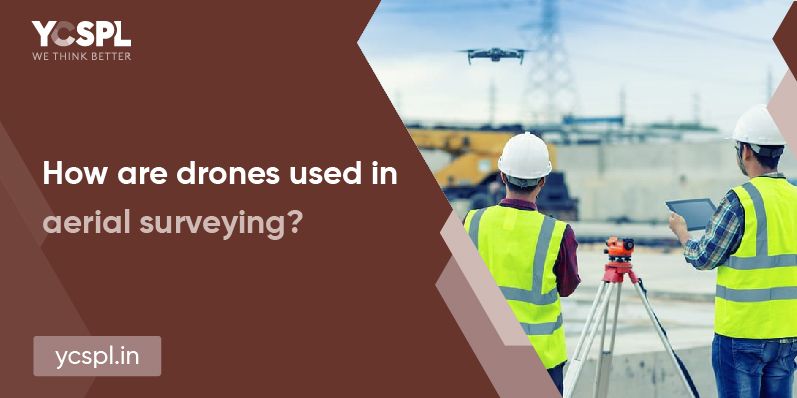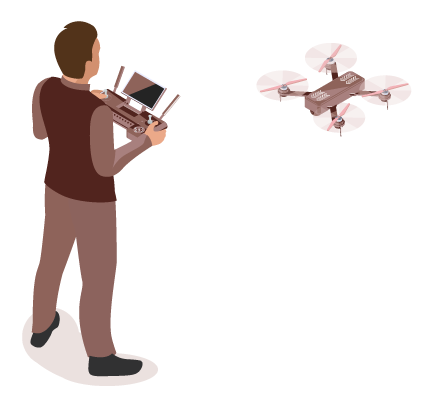
Since drones can potentially take off and land almost anywhere despite the terrain, weather, accessibility, or other environmental considerations, they’ve highly sought after. Aerial surveying is now made immensely easier with the introduction of drones in the sector because of the easy deployment they offer. It is now possible to map inaccessible areas, monitor any remote corner, and even carry out border surveillance at ease with drones configured for specific requirements.
At the same time, one single drone flight can give us a whole lot of data points all with respect to the geographical location points on the earth’s surface. Drones also carry specific payloads to capture aerial images at different angles from the above which can all be later correlated to arrive at a lot of deliverables.
When it comes to traditional surveying methods, only a limited amount of data can be measured through individual points at any point in time. But with the introduction of drone deployment and increasingly innovative payload configurations, it is possible to measure a whole lot of data points at once. All of these can be compiled at a ground station and can be manipulated to present us with the accurate solutions that we are looking for.
Integrated with GIS components, drones can help resolve the most complex problems by helping us understand the geographic connection, history, and spatial analysis of any given area.
The data from drone sources can result in the following deliverables:
All these data points can be further manipulated to produce a whole other stream of data sources that are functionally the base for a lot of other operations.
Drones eliminate the need for multiple GCPs and help us with accurate and even real-time data sources. The overall time involved in the capturing and processing of data points can thus be rewritten with the intervention of a drone survey. Did you know that drone operations are actually about 500 times faster than conventional methods?
They also make way for the lesser cost of surveying as compared to the other conventional methods like terrestrial surveying, using light aircraft or helicopter surveys. They thus account to lower overhead compared to the other methods. They’ve also thus become a cost-effective solution for private organizations in their surveying operations, property borders management, or even stockpile volumetric measurements.
UAVs are getting better each day with technologically sound configurations and improved payload specifications. Drone cameras are now able to capture videos of 5.2K resolutions on a real-time basis. These improved camera specifications, higher pixel density, and stabilization techniques have resulted in making aerial surveys with drone applications a viable choice for various operations.
It is also possible to pay close attention to even the minute details that are usually prone to be overlooked during conventional operations.

Since aerial surveying is carried out at specific heights above the ground level, there is always a risk to equipment safety. The health of the surveyors should also be given a bit of focus there since they’re also directly involved in the surveying operations.
Drones are extremely light compared to aircraft or helicopters and they pose a lesser risk after deployment. These days drone technologies are also integrated with intelligent features like risk identification, Return to Home features in the case of any operational troubles (RH), and self-assessing capabilities to understand batter health, payload conditions, etc.
At YCSPL, we have a track record of offering drone solutions with absolutely zero downtime or disaster record to date.
A lot of problems like weather conditions, risky slopes, terrain, and environmental considerations can all be crossed off the books with drone deployment. Combined with GIS applications, they provide the simplest of solutions for navigation, mapping, and understanding geographical relationships in terms of spatial coordinates.
With a pre-planned flight path, there will be only minimal operational hindrances. It is thus easy to even continuously monitor and inspect systems like windmills, telephone network towers, mines, power lines, masts, roofs, etc.
This is one of the major areas where the digital survey is highly popular. The highly accurate 3D model or orthomosaic maps of high resolutions can help us with a complete geographical understanding of any region. After processing, these can help us with on-point maps, detailed elevation models, and contour lines.
Site scouting, zonal planning, new construction developments, etc are all possible with these data points.
Combined with GIS applications, drones help in a thorough understanding of social and environmental conditions pertaining to any location. This is crucial for the developmental planning of any city to bridge all the existing gaps and make it more functional and sustainable with each new construction.
Aerial surveying services are highly sought after especially in the areas of agriculture because of the thorough geographical understanding they offer. Crop planning, disease pattern identification, weather and risk assessment, crop rotation, mitigating surface run-offs, yield prediction, etc are all now possible and the deployment of drones that are built for the purpose. At YCSPL, we have been increasingly offering solutions that are accurate and on-point through our drones.
Change becomes the most dynamic, powerful source of progress you have

